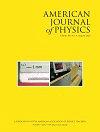Computing the shape of planet Earth
IF 0.8
4区 教育学
Q3 EDUCATION, SCIENTIFIC DISCIPLINES
引用次数: 0
Abstract
It is often noted that the Earth is slightly oblate rather than spherical, but the calculation of the Earth's eccentricity can be challenging. Here, we calculate it by minimizing the sum of the Earth's gravitational potential energy and its centrifugal potential energy. The Earth's gravitational potential energy can be derived with the help of the Green's function of the Laplace operator in oblate spheroidal coordinates. Under the assumption of a homogeneous planet, we obtain an analytic relationship for the Earth's eccentricity that was first derived by Maclaurin in 1742 and is about 13 percent larger than the observed value. Better agreement with observation is obtained by assuming that the Earth's core is about twice the density of the mantle, which reduces the Earth's moment of inertia. This exercise can provide practice in analyzing gravitational systems in spheroidal coordinates; the problem may also be relevant for other gravitating and rotating bodies, such as stars and galaxies.计算地球的形状
人们经常注意到,地球略呈扁球形而非球形,但计算地球的偏心率可能具有挑战性。在这里,我们通过最小化地球重力势能和离心势能之和来计算偏心率。地球重力势能可以借助扁球面坐标下拉普拉斯算子的格林函数求得。在均质行星的假设下,我们得到了地球偏心率的解析关系,该关系最早由麦克劳林(Maclaurin)于 1742 年得出,比观测值大约 13%。假设地核的密度大约是地幔密度的两倍,从而减小了地球的惯性矩,则与观测值的一致性会更好。这个练习可以为分析球面坐标下的引力系统提供练习;这个问题也可能与恒星和星系等其他引力体和旋转体有关。
本文章由计算机程序翻译,如有差异,请以英文原文为准。
求助全文
约1分钟内获得全文
求助全文
来源期刊

American Journal of Physics
物理-物理:综合
CiteScore
1.80
自引率
11.10%
发文量
146
审稿时长
3 months
期刊介绍:
The mission of the American Journal of Physics (AJP) is to publish articles on the educational and cultural aspects of physics that are useful, interesting, and accessible to a diverse audience of physics students, educators, and researchers. Our audience generally reads outside their specialties to broaden their understanding of physics and to expand and enhance their pedagogical toolkits at the undergraduate and graduate levels.
 求助内容:
求助内容: 应助结果提醒方式:
应助结果提醒方式:


